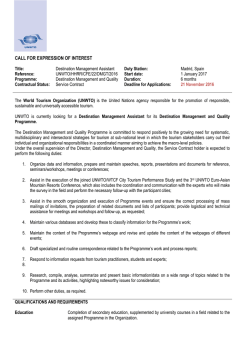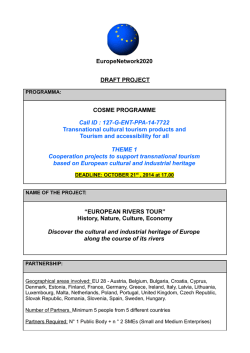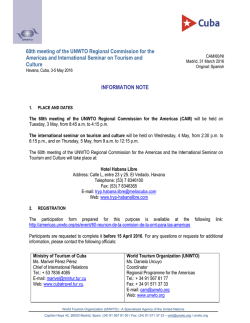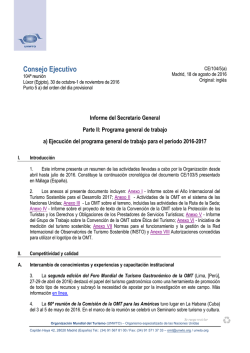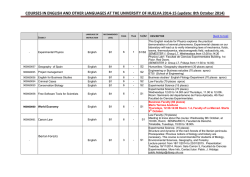
Over 1.1 billion tourists travelled abroad in 2014
Volume 13 • January 2015 Contents Regional results International tourism receipts International tourism expenditure UNWTO’s Panel of Tourism Experts UNWTO outlook for 2015 Air transport results 2014 ICAO and IATA Air transport booking trends ForwardKeys Travel Insurance Trends The economic environment Statistical Annex The number of international tourists (overnight visitors) reached 1,138 million in 2014, 51 million more than in 2013. With a 4.7% increase, 2014 marks the fifth consecutive year of robust growth above the long term average since the financial crisis of 2009. Compared to pre-crisis year 2008, international tourism gained 211 million additional arrivals a year. World: Inbound Tourism International Tourist Arrivals 1200 1100 1000 900 Over 1.1 billion tourists travelled abroad in 2014 International tourist arrivals reached 1,138 million in 2014, a 4.7% increase over the previous year, according to the data analysed in this issue of the UNWTO World Tourism Barometer. Overall demand was robust with 51 million more tourists travelling the world. For 2015, UNWTO forecasts international tourism to grow by 3% to 4%, further contributing to the global economic recovery. 1 800 700 600 1,138 1,087 1,038 997 949 910927891 854 809 764 674675696692 625 602 561587 527 500 400 19 95 19 96 19 97 19 98 19 99 20 00 20 01 20 02 20 03 20 04 20 05 20 06 20 07 20 08 20 09 20 10 20 11 20 12 20 13 20 14 This issue and the accompanying Statistical Annex of the UNWTO World Tourism Barometer present full year results for international tourism in 2014 based on preliminary data for international overnight visitors reported by destinations around the world. This analysis is complemented by data on receipts from international tourism reported by destinations around the world, as well on international tourism expenditure data for source markets for the first part of 2014. Furthermore, this issue includes an outlook for 2015 based on current trends and the assessment by the UNWTO Panel of Tourism Experts. Members of the Panel evaluated tourism development in their destination or business for the full year 2014 as well as the last four months of the year, and assessed their prospects for the full year 2015 and the first four months. Finally, it presents an overview of air transport trends in 2014 based on ICAO and IATA, as well as booking trends for the first four months of 2015 based on business intelligence tool Forwardkeys. This release is available only in electronic format, through the UNWTO elibrary, and is free of charge for members. The release is provided in English only, while the Statistical Annex is available in English, French, Spanish and Russian. (million) Source: World Tourism Organization (UNWTO) © “Over the past years, tourism has proven to be a surprisingly strong and resilient economic activity and a fundamental contributor to the economic recovery by generating billions of dollars in exports and creating millions of jobs. This has been true for destinations all around the world, but particularly for Europe, as the region struggles to consolidate its way out of one of the worst economic periods in its history,” said UNWTO SecretaryGeneral, Taleb Rifai. By region, the strongest growth in 2014 was registered in the Americas (+7%) and Asia and the Pacific (+5%), while Europe (+4%), the Middle East (+4%) and Africa (+2%) grew at a slightly more modest pace. By subregion, North America (+8%) recorded the best results, followed by North-East Asia, South Asia, Southern and Mediterranean Europe, Northern Europe and the Caribbean, all increasing by 7%. Growth in receipts expected to follow growth in international arrivals Receipts in destinations from international tourism reached US$ 1,197 billion in 2013, US$ 230 billion more compared to the precrisis year 2008. As the majority of countries compile receipts data on a quarterly basis and reporting tend to lag about two months behind arrivals data, UNWTO will analyse 2014 data in the coming months and release 2014 results for international tourism receipts in the next issue of the UNWTO World Tourism Barometer of April 2015. As in recent years, growth in receipts is expected to have followed growth in arrivals fairly closely. Volume 13 • January 2015 The UNWTO World Tourism Barometer is a publication of the World Tourism Organization (UNWTO). By monitoring short-term tourism trends on a regular basis, UNWTO aims to provide all those involved, directly or indirectly, in tourism with adequate upto-date statistics and analysis in a timely fashion. The UNWTO World Tourism Barometer is periodically updated. Issues contain as regular sections: an overview of short-term tourism data from destinations, generating countries and air transport; the results of the latest survey among the UNWTO Panel of Tourism Experts, providing an evaluation of and prospects for short-term tourism performance; and selected economic data relevant for tourism. The objective for future editions of the UNWTO World Tourism Barometer will be to broaden its scope and improve coverage gradually over time. The UNWTO World Tourism Barometer is prepared by UNWTO’s Tourism Market Trends Programme. The UNWTO Secretariat wishes to express its sincere gratitude to all those who have participated in the elaboration of the UNWTO World Tourism Barometer, in particular all institutions that supplied data, and to the members of the UNWTO Panel of Tourism Experts for their valuable contributions. For more information on the UNWTO World Tourism Barometer, including copies of previous issues, please refer to the Facts & Figures section on the UNWTO website at www.unwto.org/facts/menu.html. We welcome your comments and suggestions at [email protected], tel +34 915678198 / fax +34 915678217. The World Tourism Organization (UNWTO), a United Nations specialized agency, is the leading international organization with the decisive and central role in promoting the development of responsible, sustainable and universally accessible tourism. It serves as a global forum for tourism policy issues and a practical source of tourism know-how. Its membership includes 156 countries, 6 territories, 2 permanent observers and over 400 Affiliate Members. Copyright © 2015 World Tourism Organization Calle Capitán Haya, 42, 28020 Madrid, Spain UNWTO World Tourism Barometer ISSN: 1728-9246 Published and printed by the World Tourism Organization, Madrid, Spain - First printing: 2015 (version 27/01/15) All rights reserved The designations employed and the presentation of material in this publication do not imply the expression of any opinions whatsoever on the part of the Secretariat of the World Tourism Organization concerning the legal status of any country, territory, city or area, or of its authorities, or concerning the delimitation of its frontiers or boundaries. All UNWTO publications are protected by copyright. Therefore and unless otherwise specified, no part of an UNWTO publication may be reproduced, stored in a retrieval system or utilized in any form or by any means, electronic or mechanical, including photocopying, microfilm, scanning, without prior permission in writing. UNWTO encourages dissemination of its work and is pleased to consider permissions, licensing, and translation requests related to UNWTO publications. For permission to photocopy UNWTO material, refer to the UNWTO website at www.unwto.org/pub/rights.htm. The contents of this issue may be quoted provided the source is given accurately and clearly. Distribution or reproduction in full is permitted for own or internal use only. Please do not post electronic copies on publicly accessible websites, UNWTO encourages you to include a link to the Facts & Figures section of the UNWTO website instead at mkt.unwto.org. World Tourism Organization Capitán Haya 42, 28020 Madrid, Spain Tel (34) 91 567 81 00 / Fax (34) 91 571 37 33 [email protected] www.unwto.org Data collection for this issue was closed mid January 2015. The next issue of the UNWTO World Tourism Barometer is scheduled to be published April 2015. 2 Volume 13 • January 2015 Equal 100 75 Worse 50 131 140 139 127 122 121 125 129 138 136 133 125 98 Better 150 Prospects (before) 71 72 Looking ahead, the UNWTO Confidence Index –based on feedback from over 300 tourism experts worldwide – suggests tourism growth will continue in 2015. Experts expect tourism performance to be better in 2015, though they were not as upbeat as a year ago with regard to their expectations for 2014. Based on current trends and the UNWTO Confidence Index, UNWTO forecasts international tourist arrivals to grow between 3% and 4% in 2015. By region, growth is expected to be strongest in the Americas and in Asia and the Pacific (both +4% to +5%), and somewhat more moderate in Europe (+3% to +4%). Africa (+3% to +5%) and the Middle East (+2% to +5%) are two regions with a larger degree of uncertainty and volatility. “We expect demand to continue growing in 2015 as the global economic situation improves even though there are still plenty of challenges ahead. On the positive side, oil prices have declined to a level not seen since 2009. This will lower transport costs and boost economic growth by lifting purchasing power and private demand in oil importing economies. Yet, it could also negatively impact some of the oil exporting countries which have emerged as strong tourism source markets,” added Mr Rifai. 119 175 150 144 144 140 140 136 137 143 132 UNWTO Panel of Tourism Experts: World Favourable prospects for 2015 Evaluation (after) 25 2003 2004 2005 2006 2007 2008 2009 2010 2011 2012 2013 2014 2015 Source: World Tourism Organization (UNWTO) © Crude Oil Spot Price Brent (daily) (US$ per barrel) 160 140 120 100 80 60 International Tourist Arrivals, World 12 40 20 10.4 10 0 7.8 8 6.4 6 4.5 4 (% change) 6.5 5.9 5.7 6.5 2.6 3.8 2 3.1 5.1 4.1 Source: US Department of Energy, Energy Information Administration 4.7 4.7 1.9 All world regions shared in growth in 2014 0.2 0 -0.6 -2 -4 Europe (+4%), the most visited region with over half of the world’s international tourists, saw an increase of 22 million arrivals in 2014, reaching a total of 588 million. Thanks to these results, tourism has been a major contributor to the European economic recovery. Northern Europe and Southern and Mediterranean Europe led growth (both +7%), while results were more modest in Western Europe (+2%). Arrivals in Central and Eastern Europe (0%) stagnated after three years of strong growth. The 28 countries of the European Union together recorded 457 million international arrivals in 2014, an increase of 5%, higher than in 2013 (+4%). -3.9 96 /9 97 5 /96 98 /9 99 7 /9 00 8 /99 01 /0 02 0 /01 03 /0 04 2 /0 05 3 /0 06 4 /05 07 /0 08 6 /0 09 7 /0 10 8 /0 11 9 / 12 10 * /1 13 1 */ Fo rec 14* 12 as /13 t2 01 5 -6 Long-term average Source: World Tourism Organization (UNWTO) © Outlook for International Tourist Arrivals 2009 2010 World Europe Asia and the Pacific Americas Africa Middle East -3.9% -5.0% -1.6% -4.7% 3.4% -5.4% 6.5% 3.1% 13.1% 6.5% 8.9% 13.1% Source: World Tourism Organization (UNWTO) © 3 1987 1989 1991 1993 1995 1997 1999 2001 2003 2005 2007 2009 2011 2013 2015 2011 2012 real, change full year 5.1% 4.1% 6.6% 3.7% 6.5% 6.9% 3.5% 4.4% -0.1% 5.2% -3.5% -5.6% 2013 2014* 4.7% 5.0% 6.8% 3.5% 4.8% -3.4% Jan.-Dec. 4.7% 3.9% 5.3% 7.4% 2.2% 4.4% projection 2014* (issued January) between +4% and +4.5% +3% and +4% +5% and +6% +3% and +4% +4% and +6% +0% and +5% average a year 2005-2014 3.9% 3.0% 6.1% 3.4% 5.4% 4.6% projection 2015* (issued January) between +3% and +4% +3% and +4% +4% and +5% +4% and +5% +3% and +5% +2% and +5% (Data as collected by UNWTO January 2015) Volume 13 • January 2015 International Tourist Arrivals by (Sub)region Full year Share Change Monthly/quarterly data series (percentage change over same period of the previous year) 2000 2005 2010 2012 2013 2014* 2014* 12/11 13/12 14*/13 (million) (%) 100 4.1 2014* 2013 (%) Q1 Q2 Q3 Q4 Sep Oct Nov Dec Q1 Q2 Q3 Q4 4.7 4.7 3.9 5.8 4.3 4.8 3.9 5.8 4.1 4.2 6.3 4.3 4.1 4.1 World 674 809 949 1,038 1,087 1,138 Advanced economies¹ 419 463 510 555 582 615 54.0 3.8 4.8 5.7 4.8 7.6 4.9 5.5 4.9 7.1 4.9 4.2 4.7 3.8 5.3 5.6 Emerging economies¹ 255 346 439 482 505 523 46.0 4.4 4.7 3.6 3.1 3.6 3.5 4.0 2.7 4.4 3.4 4.2 7.8 5.0 2.4 2.5 386.4 452.9 488.3 539.6 566.3 588.4 4.9 By UNWTO regions: Europe Northern Europe 51.7 3.7 5.0 3.9 2.9 5.1 3.6 3.6 3.3 4.5 2.9 3.2 5.7 4.2 4.7 72.6 6.4 1.4 4.1 6.9 8.9 8.5 5.8 4.8 7.1 3.8 5.3 5.6 3.4 2.5 4.6 6.0 139.7 141.7 154.4 167.3 171.8 175.6 15.4 3.6 2.7 2.2 -0.5 4.9 1.3 2.8 1.7 3.8 2.0 2.2 2.8 1.3 3.2 3.7 44.8 Western Europe Central/Eastern Eu. 59.8 69.3 Southern/Mediter. Eu. 62.7 95.1 65.3 68.0 97.9 116.7 125.6 125.1 11.0 8.5 7.6 -0.4 1.6 -0.5 -1.8 0.4 -1.9 0.5 0.3 0.5 11.8 7.4 6.5 2.8 132.6 156.4 173.3 190.4 201.0 215.2 18.9 1.9 5.6 7.0 5.1 6.4 7.5 5.0 5.8 5.4 5.4 5.0 7.2 7.5 7.7 6.6 - of which EU-28 330.5 367.8 383.7 416.7 433.7 456.6 40.1 2.8 4.1 5.3 3.3 6.6 5.0 5.5 5.5 6.4 5.0 4.7 3.6 3.0 4.6 5.4 Asia and the Pacific 110.3 154.0 205.4 233.8 249.8 263.0 23.1 6.9 6.8 5.3 5.0 5.6 4.0 6.5 4.1 7.3 5.6 6.7 8.3 6.1 7.6 5.5 6.0 3.7 1.6 4.4 4.1 14.8 12.1 11.7 7.2 4.1 4.3 5.0 North-East Asia 58.3 85.9 111.5 122.8 127.0 136.0 3.4 7.1 5.2 8.6 6.4 8.2 6.2 8.8 8.8 7.0 South-East Asia 36.3 49.0 70.5 84.7 94.3 96.6 8.5 8.7 11.3 2.4 4.5 0.6 -0.4 4.7 0.6 5.3 1.7 6.7 9.6 10.9 11.4 11.9 12.5 13.2 1.2 4.2 5.9 4.9 8.3 6.0 4.5 6.1 6.7 5.5 6.1 8.1 12.0 14.4 16.0 17.1 1.5 128.2 133.3 150.5 162.5 168.1 180.6 15.9 Oceania South Asia Americas 11.9 4.6 4.7 4.9 5.9 11.4 7.1 5.9 7.8 9.5 5.4 6.7 6.9 2.9 6.5 10.6 13.2 15.4 7.7 4.4 7.4 5.3 11.8 6.6 6.3 4.2 8.8 5.8 4.5 3.1 4.0 4.5 3.5 1.9 North America 91.5 89.9 99.5 106.4 110.5 119.5 10.5 4.1 3.9 8.2 6.9 13.3 6.4 6.3 3.6 9.7 6.8 2.7 4.4 2.9 4.3 3.8 Caribbean 17.1 18.8 19.5 20.6 21.1 22.5 2.0 3.1 2.8 6.6 3.7 7.5 7.6 8.4 8.1 10.5 7.9 7.5 1.0 -0.2 1.8 6.5 Central America 4.3 6.3 7.9 8.9 9.1 9.6 0.8 7.3 2.6 5.6 3.7 9.2 4.3 5.8 5.4 3.3 3.5 9.3 3.2 0.6 2.2 3.9 South America 15.3 18.3 23.5 26.7 27.4 29.0 2.5 5.8 2.7 5.7 2.4 9.6 7.5 4.8 4.5 5.6 1.4 6.9 0.8 0.0 4.2 6.0 5.7 Africa 26.2 34.8 49.7 52.2 54.7 56.0 4.9 5.2 4.8 2.3 6.2 2.3 1.9 -1.0 -1.4 -1.8 -0.1 -1.1 3.1 2.5 5.7 North Africa 10.2 13.9 18.8 18.5 19.6 19.7 1.7 8.7 6.0 0.6 7.9 1.8 1.1 -8.8 -4.7 -9.6 -6.5 -9.6 0.1 0.7 7.1 4.8 Subsaharan Africa 16.0 20.9 30.9 33.7 35.1 36.3 3.2 3.4 4.2 3.3 5.5 2.6 2.5 2.7 2.4 2.4 4.4 3.7 4.6 6.2 22.4 33.7 54.7 49.8 48.2 50.3 4.4 -5.6 -3.4 4.4 0.2 0.1 13.8 7.0 24.9 11.0 5.9 2.4 14.4 Middle East 2.5 0.6 Source: World Tourism Organization (UNWTO) © 6.6 -25.0 -13.0 (Data as collected by UNWTO January 2015) ¹ Classification based on the International Monetary Fund (IMF), see the Statistical Annex of the IMF World Economic Outlook of April 2012, page 177, at www.imf.org/external/pubs/ft/weo/2012/01. See box at page 'Annex-1' for explanation of abbreviations and signs used International Tourist Arrivals, monthly evolution World 140 (million) 2011 120 (% change) 15 2010 130 International Tourist Arrivals, monthly evolution World 10 2012 110 2013 100 2014* 5 0 90 80 -5 70 -10 60 50 -15 1 2 3 4 5 6 Source: World Tourism Organization (UNWTO) © 4 7 8 9 10 11 12 2009 2010 2011 Source: World Tourism Organization (UNWTO) © 2012 2013 2014* Volume 13 • January 2015 International Tourist Arrivals 8 6 (% change) 7 6.8 5 5.0 4.7 5 4 4 4.8 4 3.5 2 2 0 13/12 -2 14*/13 -4 World Europe Asia and the Pacific Americas Africa -3.4 Middle East Source: World Tourism Organization (UNWTO) © International tourist arrivals in Asia and the Pacific (+5%) increased by 13 million to 263 million. The best performance was recorded in North-East Asia and South Asia (both +7%). Arrivals in Oceania grew by 6%, while growth slowed down in South-East Asia (+2%) as compared to previous years. The Americas was the best performing region in relative terms with a growth of 7%, welcoming an additional 13 million international tourists and raising the total to 181 million. Growth was driven by North America (+8%), where Mexico posted a double-digit increase, and the Caribbean (+7%). Arrivals to Central America and South America (both +6%) also grew at double the rate recorded in 2013 and well above the world average. International tourism in the Middle East (+4%) shows signs of rebound with good results in most destinations. The region attracted an additional 2 million arrivals, bringing the total to 50 million. Africa’s international tourist numbers grew by an estimated 2%, equivalent to an increase of one million arrivals. The region reached 56 million tourists. While arrivals to North Africa were weak (+1%), Sub-Saharan Africa saw international tourist numbers rise by 3% despite the Ebola Disease Outbreak in a few West African countries. Data for Africa and the Middle East should be read with caution as it is based on limited and volatile data. The detailed information in the continuation of the UNWTO World Tourism Barometer and its Statistical Annex is not included in the complimentary excerpt of this document. The full document is available in electronic format for sale and free of charge for UNWTO members and subscribed institutions through the UNWTO elibrary at www.e-unwto.org/content/w83v37. For more information on the UNWTO World Tourism Barometer, please refer to the Facts & Figures section on the UNWTO website at www.unwto.org/facts. Copyright © 2015 World Tourism Organization 5 Volume 13 • January 2015 International Tourist Arrivals (% change over same period of the previous year) 14 13/12 11 11 12 10 8 6 4.7 4.7 8 8 7 7 7 7 6 5 4 3 7 6 6 4 14*/13 4 4 4 3 3 2 2 6 6 3 3 3 2 0 0 0 -2 -4 -3 Source: World Tourism Organization (UNWTO) © www2.unwto.org/event/fitur-2015 6 an Af ric a Mi dd le Ea st Su bs a ha r Af ric a ica No rth Am er me ric a So uth n ica be a Ce ntr al A Ca rib me r As ia No rth A So uth nia Oc ea Eu Ce rop ntr e al/ Ea st e So rn uth Eu ern . /M ed ite r. E u. No rth -E as tA sia So uth -E as tA sia pe W es ter n rn Eu ro No rth e W orl d -6 UNWTO World Tourism Barometer The UNWTO World Tourism Barometer aims at providing all those involved in tourism with up-to-date statistics and adequate analysis, in a timely fashion. Issues cover shortterm tourism trends, a retrospective and prospective evaluation of current tourism performance by the UNWTO Panel of Experts, and a summary of economic data relevant for tourism. The information is updated throughout the year. Available in English, French, Spanish and Russian Tourism Towards 2030 UNWTO Tourism Towards 2030 is UNWTO’s long-term outlook and assessment of future tourism trends from 2010 to 2030. It is a broad research project building on UNWTO’s on-going work in the field of long-term forecasting, initiated in the 1990s. Key outputs of the study are quantitative projections for international tourism flows up until 2030, based on data series on international tourist arrivals by subregion of destination, region of origin and mode of transport for the period 1980-2010. Available in English Handbook on E-Marketing for Tourism Destinations (revised version) This UNWTO/ETC fully revised and extended version 3.0 covers all essential aspects of an e-marketing strategy including strategic planning, branding measures, contentbuilding, search engine optimization, e-commerce and email marketing. It also provides practical information on latest trends and developments in mobile marketing and social media, as well as detailed insight into the measurement of effective e-marketing strategies using the latest technologies. Available in English Handbook on Tourism Product Development The UNWTO/ETC Handbook on Tourism Product Development outlines the essential elements in the process of tourism product development planning and implementation. It demonstrates a range of successful approaches and case studies from around the world and sets out best practice examples and benchmarks by which destinations can assess their own product development system and methods. Available in English The Chinese Outbound Travel Market and Understanding Chinese Outbound Tourism China is the fastest-growing tourism source market in the world and the top international tourism spender since 2012. In view of the worldwide interest in this market, ETC and UNWTO have prepared two joint reports on this subject: The Chinese Outbound Travel Market – 2012 Update, which offers an overview of the features and rapid evolution of the Chinese outbound tourism market, and Understanding Chinese Outbound Tourism – What the Chinese Blogosphere is Saying about Europe, which analyses the trends, themes and behaviour of Chinese tourists based on the analysis of online social media and internet searches. Available in English Understanding Brazilian Outbound Tourism – What the Brazilian blogosphere is saying about Europe With over 70 million internet users in 2012, Brazil has Latin America’s biggest population of ‘netizens’ or social media users, the 5th largest in the world. An increasing number of National Tourist Organizations (NTO’s) are interested in targeting this important market through websites, blogs and other social media. This joint research project by ETC and UNWTO analyses the trends, themes and behaviour of Brazilian tourists in Europe based on internet searches and social media activity. Available in English Compendium of Tourism Statistics, 2014 Edition, Data 2008–2012 The Compendium of Tourism Statistics provides data and indicators on inbound, outbound and domestic tourism, as well as on the number and types of tourism industries, the number of employees by tourism industries, and macroeconomic indicators related to international tourism. The 2014 edition presents data for 203 countries from 2008 to 2012, with methodological notes in English, French and Spanish. Yearbook of Tourism Statistics, 2014 Edition, Data 2008–2012 The Yearbook of Tourism Statistics focuses on inbound tourism-related data (total arrivals and overnight stays), broken down by country of origin. The 2014 edition presents data for 197 countries from 2008 to 2012, with methodological notes in English, French and Spanish. Handbook on Tourism Destination Branding This handbook is a recognition by UNWTO and ETC of the value of successfully building and managing a destination’s brand. With an Introduction by Simon Anholt, the handbook presents a step-by-step guide to the branding process, accompanied by strategies for brand management. Given case studies illustrate concepts, present best practices from around the world and provide fresh insight into destination branding. Available in English and Spanish The easy way to obtain UNWTO publications in print or electronic format and download full catalogue: www.unwto.org/pub
© Copyright 2025
